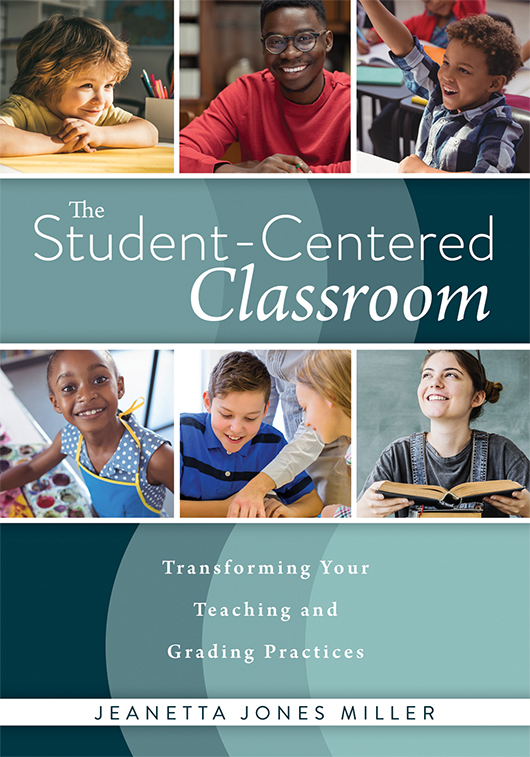Free Reproducibles
The Student-Centered Classroom Reproducibles
Transforming Your Teaching and Grading Practices
Empower students to become creative, well-rounded citizens who are prepared to meet and overcome real-world challenges.
Student-centered classrooms make it possible for schools to fulfill their best and most enduring promise: to give students a fair chance to grow up literate, open-minded, and prepared to succeed. With this resource as your guide, you will learn six teaching practices to help you leave behind one-size-fits-all lessons, tests, and grades in favor of a student-centered approach that is interactive, individualized, and rigorous.
Benefits
- Learn how to use the two essential qualities of education, respect and agency, to help students achieve learning goals.
- Find affirmation in being part of a community of educators that is creating the potential for a much-needed shift in the approach to education and academic rigor.
- Discover how to use speaking, listening, writing, and reading in new and creative ways.
- Explore the essential components of a student-centered approach to evaluation and assessment.
- Understand how to counter misconceptions about student-centered learning when communicating with colleagues, administrators, and parents.
TABLE OF CONTENTS
Chapter 1: Encourage Academic Success
Chapter 2: Support Personal Growth
Chapter 3: Make Space for Speaking and Listening
Chapter 4: Deepen Understanding With Writing and Reading
Chapter 5: Meet Individual Needs in the Evaluation Process
Chapter 6: Communicate With the School Community
Epilogue: Conclusion
Appendix: Frequently Asked Questions
STUDY GUIDE
REPRODUCIBLES
Chapter 1
- Figure 1.2: Collaboration Learning Goals for Elementary Students
- Figure 1.3: Collaboration Learning Goals for Secondary Students
- Figure 1.4: Collaboration Group Reflection Questions
- Figure 1.5: Peer-Conference Group Guidelines for Elementary Students
- Figure 1.6: Peer-Conference Guidelines for Secondary Students
- Figure 1.7: Directions for Demonstrating a Bad Peer Conference
- Figure 1.8: Attitude Survey for an English Class
- Next Steps for Encouraging Academic Success
Chapter 2
- Figure 2.1: Guidelines for an Essay Assignment
- Figure 2.2: Six Steps to the Practice of Thoughtful Decision Making
- Next Steps for Supporting Personal Growth
Chapter 3
- Figure 3.1: Worksheet for Paired Interviews
- Figure 3.2: Role Play Guidelines
- Figure 3.3: Choral-Reading Performance Guidelines for Elementary Students
- Figure 3.4: Choral-Reading Performance Guidelines for Secondary Students
- Figure 3.6: Occasional Paper Guidelines for Elementary Students
- Figure 3.7: Occasional Paper Guidelines for Secondary Students
- Figure 3.10: Student-Feedback Form for Presentations
- Next Steps for Making Space for Speaking and Listening
Chapter 4
- Figure 4.3: Researched Narrative Guidelines for Elementary Students
- Figure 4.4: Researched Narrative Guidelines for Secondary Students
- Figure 4.5: Interview Guidelines for Elementary Students
- Figure 4.6: Interview Guidelines for Secondary Students
- Figure 4.7: Survey Guidelines for Elementary Students
- Figure 4.8: Survey Guidelines for Secondary Students
- Figure 4.9: Survey-Feedback Guidelines for Secondary Students
- Figure 4.10: Letter to the Editor Guidelines for Elementary Students
- Figure 4.11: Letter to the Editor Guidelines for Secondary Students
- Figure 4.12: Text-Based Discussion Guidelines for Elementary Students
- Figure 4.13: Text-Based Discussion Guidelines for Secondary Students
- Next Steps for Deepening Understanding With Writing and Reading
Chapter 5
- Figure 5.5: Fifth-Grade Self-Evaluation Chart for Mathematics Learning Goals
- Figure 5.6: Fifth-Grade Student Progress Log for Mathematics Learning Goals
- Figure 5.7: Student Progress Log for Spoken Communication Learning Goals
- Next Steps for Meeting Individual Needs in the Evaluation Process
Chapter 6
SUGGESTED RESOURCES
Books
- Marzano, R. J. (2017). The New Art and Science of Teaching. Bloomington, IN: Solution Tree Press.
- Marzano, R. J. (2018). Making Classroom Assessments Reliable and Valid. Bloomington, IN: Solution Tree Press.
- Pandolpho, B. (2020). I’m Listening: How Teacher-Student Relationships Improve Reading, Writing, Speaking, and Listening. Bloomington, IN: Solution Tree Press.
- Reeves, D. B. (2015). Inspiring Creativity and Innovation in K–12. Bloomington, IN: Solution Tree Press.
- Reeves, D. B., & Reeves, B. (2017). The Myth of the Muse: Supporting Virtues That Inspire Creativity. Bloomington, IN: Solution Tree Press.
- Schimmer, T. (2016). Grading From the Inside Out: Bringing Accuracy to Student Assessment Through a Standards-Based Mindset. Bloomington, IN: Solution Tree Press.

